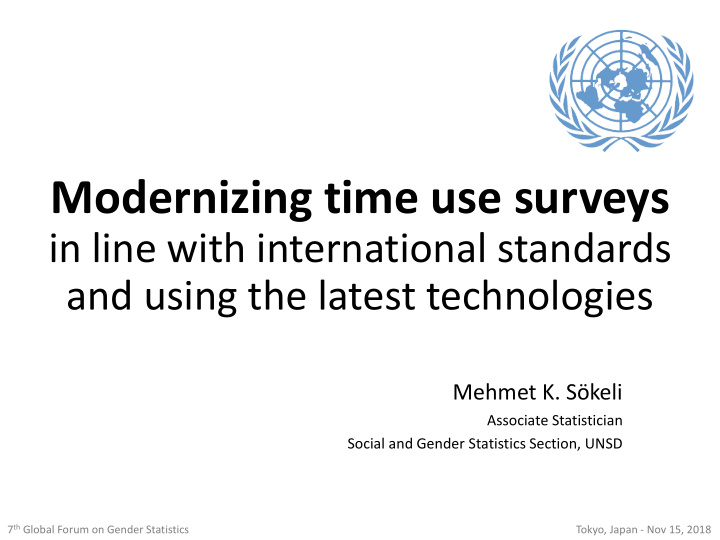



Modernizing time use surveys in line with international standards and using the latest technologies Mehmet K. Sökeli Associate Statistician Social and Gender Statistics Section, UNSD 7 th Global Forum on Gender Statistics Tokyo, Japan - Nov 15, 2018
Rationale for time-use statistics Indicator 5.4.1 Proportion of time spent on unpaid domestic and care work, by sex, age Gender and location Well-being 18.4% Unpaid care work Unpaid domestic work 7.0% Paid work Leisure Source: SDGs Report 2017, % of time spent per day, median values, 2000-2016 Environment Voluntary work Health and safety Energy Travel 7 th Global Forum on Gender Statistics Tokyo, Japan - Nov 15, 2018
The trade-off Instruments Use of data (our goal is to maximize these) Modes Data quality Data granularity Utilization Cross-country comparisons Cost (our goal is to minimize these) Economic resources Human resources Coding complexity Respondents’ burden Time constraints 7 th Global Forum on Gender Statistics Tokyo, Japan - Nov 15, 2018
Instruments Around 100 countries that have collected time-use data since 2000: Full-time diary Light-time diary Stylized questions Economic resources Economic resources Respondents’ burden Respondents’ burden Coding complexity Coding complexity Data quality Data quality Data granularity Data granularity Utilization Utilization 7 th Global Forum on Gender Statistics Tokyo, Japan - Nov 15, 2018
Modes PAPI Face to face CAPI Recall Interview CATI Over the network Leave-behind Paper diary diary Technology assisted CAWI Self-reported self-interview Mobile app Experience sampling method Wearable In person device observation Observation Mobile app Technology assisted observation SMS / Outbound IVR Tokyo, Japan - Nov 15, 2018 7 th Global Forum on Gender Statistics
Modes PAPI Face to face CAPI Coding complexity Recall Interview CATI Over the network Coding complexity Leave-behind Paper diary diary Coding complexity Technology assisted CAWI Self-reported Respondent’s burden self-interview Coding complexity Mobile app Experience Respondent’s burden sampling method Data granularity v Sleep 9- Self-care and maintenance v 9- Self-care and maintenance 911 – night sleep/essential sleep Cross-country 91- Sleep and related activities 912 – incidental sleep/nap comparisons 92- Eating and drinking 913 – sleeplessness 93- Personal hygiene and care 914 – other sleep and related activities … 7 th Global Forum on Gender Statistics Tokyo, Japan - Nov 15, 2018
Modes Around 100 countries that have collected time-use data since 2000: Face to face interview 15 CATI 2 Self-reported paper diary 31 Mixed-mode 10 Not yet identified 47 12 th IAEG-GS Meeting Tokyo, Japan - Nov 13, 2018
Mixed-mode strategy Mixed-mode in data collection try to combine the best of all possible worlds by exploiting the advantages of different modes and compensate for their weaknesses at an affordable cost (De Leeuw 2005). Advantages behavioral science Response rate Cost Possible limitations Data quality (mode effect) Coding complexity (data integration from multiple modes) 7 th Global Forum on Gender Statistics Tokyo, Japan - Nov 15, 2018
EDGE Phase 2 to improve national capacity in producing comprehensive time use data that meet international standards and use the latest technologies • Data collection mode effect • Comparative study of diaries vs. stylized questions using digital data collection modes, including in developing countries • Need and implications of having a reference day in the survey • How to better utilize available mobile networks for TU data collection • Combining time diaries with summary questions for collecting information about infrequent activities requiring further probing 7 th Global Forum on Gender Statistics Tokyo, Japan - Nov 15, 2018
Thank you! United Nations Statistics Division (UNSD) Gender Statistics Portal https://genderstats.un.org 7 th Global Forum on Gender Statistics Tokyo, Japan - Nov 15, 2018
Recommend
More recommend